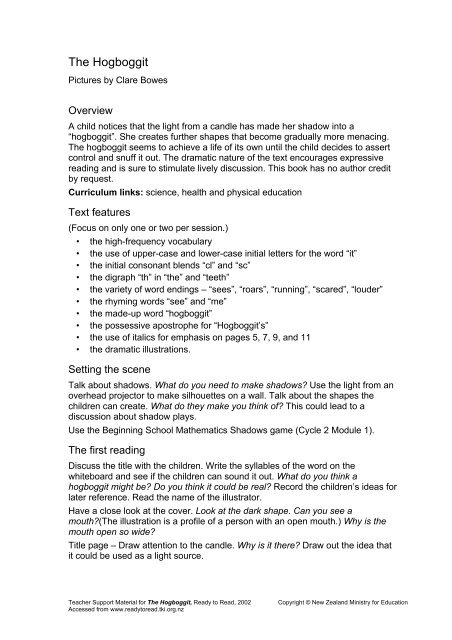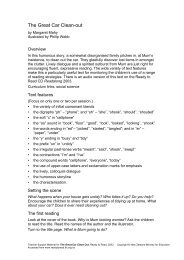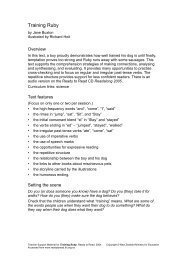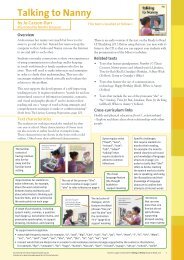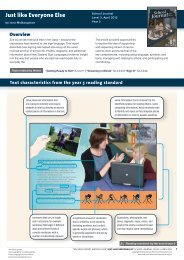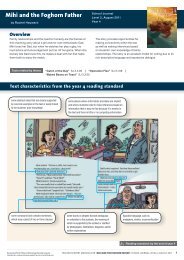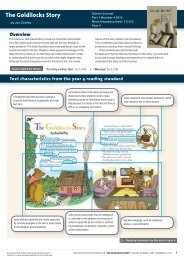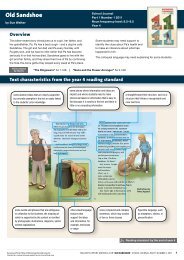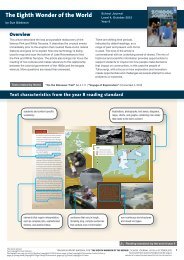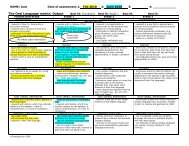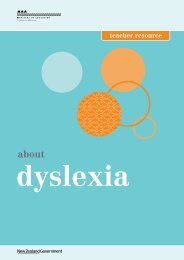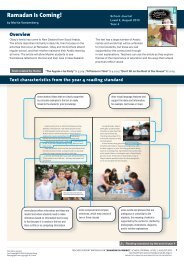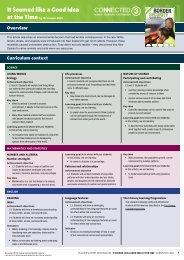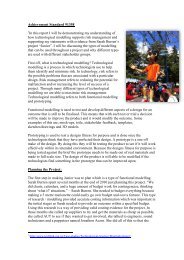The Hogboggit TSM Yellow - Literacy Online
The Hogboggit TSM Yellow - Literacy Online
The Hogboggit TSM Yellow - Literacy Online
Create successful ePaper yourself
Turn your PDF publications into a flip-book with our unique Google optimized e-Paper software.
<strong>The</strong> <strong>Hogboggit</strong>Pictures by Clare BowesOverviewA child notices that the light from a candle has made her shadow into a“hogboggit”. She creates further shapes that become gradually more menacing.<strong>The</strong> hogboggit seems to achieve a life of its own until the child decides to assertcontrol and snuff it out. <strong>The</strong> dramatic nature of the text encourages expressivereading and is sure to stimulate lively discussion. This book has no author creditby request.Curriculum links: science, health and physical educationText features(Focus on only one or two per session.)• the high-frequency vocabulary• the use of upper-case and lower-case initial letters for the word “it”• the initial consonant blends “cl” and “sc”• the digraph “th” in “the” and “teeth”• the variety of word endings – “sees”, “roars”, “running”, “scared”, “louder”• the rhyming words “see” and “me”• the made-up word “hogboggit”• the possessive apostrophe for “<strong>Hogboggit</strong>’s”• the use of italics for emphasis on pages 5, 7, 9, and 11• the dramatic illustrations.Setting the sceneTalk about shadows. What do you need to make shadows? Use the light from anoverhead projector to make silhouettes on a wall. Talk about the shapes thechildren can create. What do they make you think of? This could lead to adiscussion about shadow plays.Use the Beginning School Mathematics Shadows game (Cycle 2 Module 1).<strong>The</strong> first readingDiscuss the title with the children. Write the syllables of the word on thewhiteboard and see if the children can sound it out. What do you think ahogboggit might be? Do you think it could be real? Record the children’s ideas forlater reference. Read the name of the illustrator.Have a close look at the cover. Look at the dark shape. Can you see amouth?(<strong>The</strong> illustration is a profile of a person with an open mouth.) Why is themouth open so wide?Title page – Draw attention to the candle. Why is it there? Draw out the idea thatit could be used as a light source.Teacher Support Material for <strong>The</strong> <strong>Hogboggit</strong>, Ready to Read, 2002Accessed from www.readytoread.tki.org.nzCopyright © New Zealand Ministry for Education
Pages 2 and 3 – Look closely at the double-page illustration, discussing how thechild’s shadow will project onto the wall if she stands in front of the light.Reassure the children that an adult would be supervising, even though there is noadult shown in the illustration. Refer back to their ideas about what a hogboggitmight be. What do you think now?Listen to the children read the text themselves, supporting them as necessary. Asthey move through the book, encourage them to focus on each double-pageillustration in order to clarify the link between the child’s actions and the shadowsshe is creating.Page 5 – Why is the word “my” written in italics? How does the author want you tosay this word?Page 6 – <strong>The</strong> children will need to attend to the visual features of the word “toes”.From the illustration, the word could be “legs” or “feet”.Page 8 – Draw the children’s attention to the end sound of “teeth”.Page 10 – Note those children who are able to use visual features to confirm theword “claws”.Page 12 – What is the hogboggit doing now? Why is its mouth open so wide?Note that the hogboggit is now shown in close-up and on the left-hand page,subtly suggesting that it is becoming bigger and more powerful.Pages 14 and 15 – Who is really running away?Page 16 – Where has the hogboggit gone? Could it come back? How?Ideas for revisiting the text(Choose only one or two per session.)Listen to the children reread the text, observing their integration of strategies anduse of expression.Focus on the digraph “th”. Show the children how they can use their knowledge of“th” as an initial sound to help them decode words when the “th” is at the end (asin “teeth”) or in the middle of a word. Write words that include this digraph (“teeth”,“with”, “bath”, “cloth”, “mother”, “father”) on the whiteboard and ask the children tounderline the “th” in the words.Focus on the initial consonant blends “cl” or “sc”. List other words that start thisway. Note that “sk” has the same sound as “sc”. An extension activity could be toshow the children some words beginning with “sc” that do not have the “sk” sound(for example, “scene” and “science”).Focus on the words “it” and “It”. Find examples in the text. Why does the wordsometimes start with a capital letter? Is it the same word? Some children find ithard to accept that words such as “It”, “Is”, or “In” are actually the same words asthe lower-case versions.Look closely at the word “hogboggit” and talk about how the children worked it out.List other words that rhyme with “hog” and “bog”. List other words that rhyme with“git”. Encourage the children to be flexible with language by putting some of thewords from the lists together to create new names for an imaginary creature.Focus on the word “louder”. Think of other comparative verbs, such as “higher”,“faster”, and “smarter”.Teacher Support Material for <strong>The</strong> <strong>Hogboggit</strong>, Ready to Read, 2002Accessed from www.readytoread.tki.org.nzCopyright © New Zealand Ministry for Education
Discuss the use of italics and exclamation marks for emphasis. Why is “my”written this way? What does it tell us? Reread the text together, focusing on theuse of expression.Suggestions for further activitiesUsing an overhead projector, make shadows or silhouettes on the wall. Discussthe shapes and what they could be. <strong>The</strong> children could draw around them and cutthem out.Ask the children to create their own pictures of the hogboggit. Label the variousparts.<strong>The</strong> children could construct their own creature and invent a name for it.As a group, write an explanation or a diagram of how they could create a shadow.Teacher Support Material for <strong>The</strong> <strong>Hogboggit</strong>, Ready to Read, 2002Accessed from www.readytoread.tki.org.nzCopyright © New Zealand Ministry for Education


